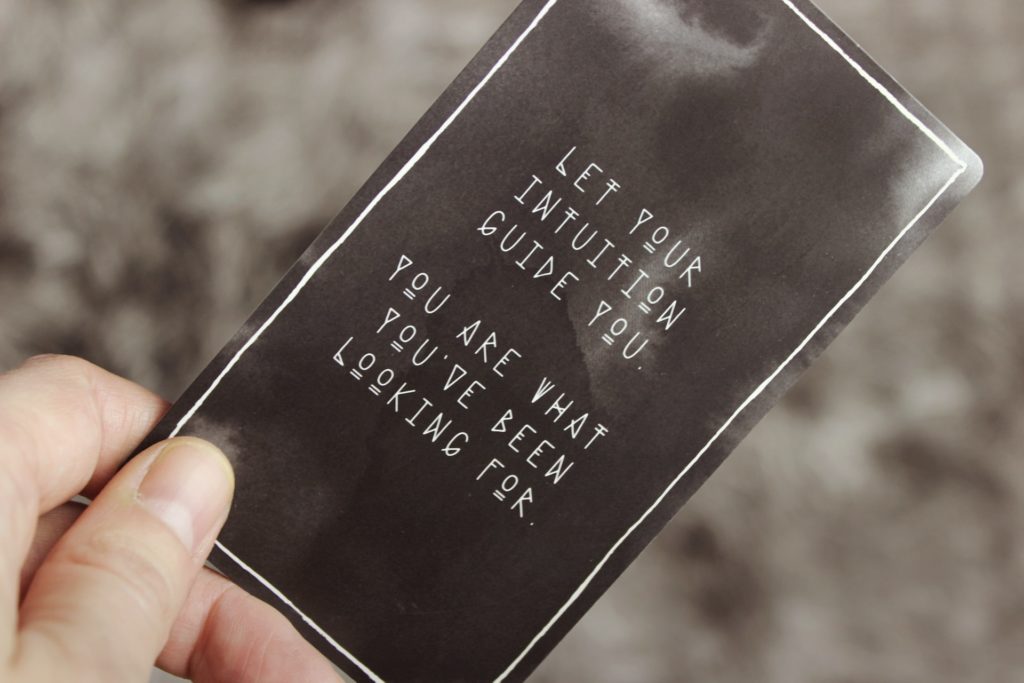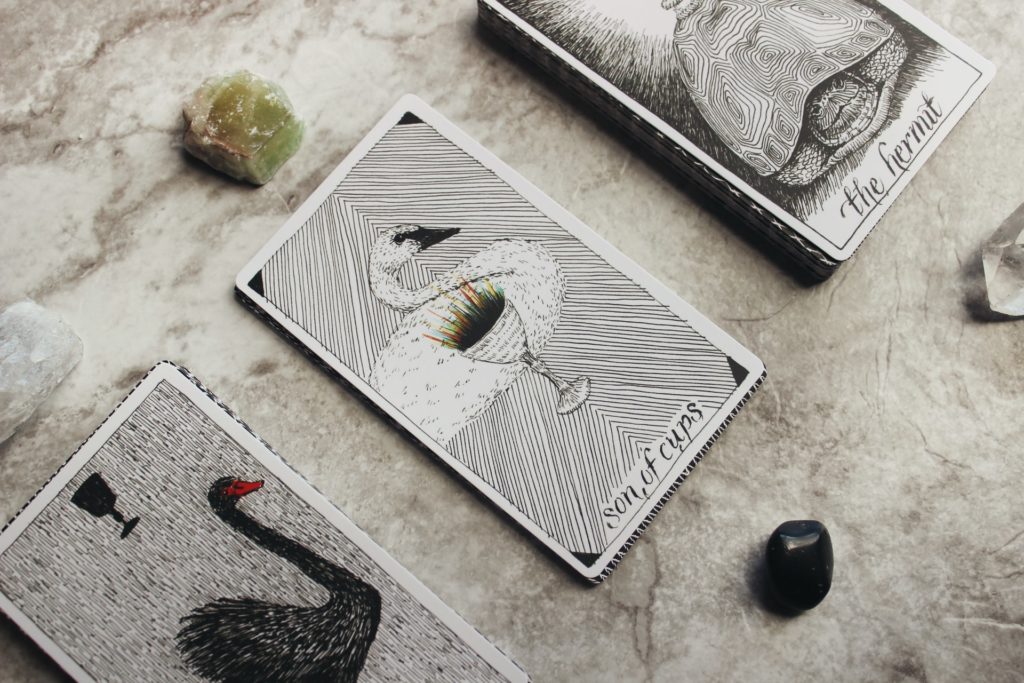Tarot, oracle, animal spirit – you name it, there’s a deck for it these days. Discovering how to use tarot cards for self-growth has become a modern mindfulness phenomenon allowing ordinary people to dive into the realm of the mystical without the help of an expensive professional.
While tarot may seem like some other-worldly esoteric device, the 78 archetypes of the tarot deck simply tell the story of the shared human experience; All of the desires, struggles, wisdom, and mysteries that intrinsically bind us together as human beings. A tarot deck is a mirror, with each card representing a tiny window into the collective human consciousness.
At its core, tarot is a tool for the conscious inquisition into the self, providing us a guide by which to assess and reflect on our own lives. But what does this actually look like in practice?
A Mystical Journey into Mindfulness
Many people come to mindfulness practices like tarot and journaling seeking the same thing: peace of mind. If the mind is an ocean, constantly churning with currents and crashing waves, then achieving peace of mind would look like smooth, glassy waters. No violent crashing, no tides threatening to pull you off course.
While this might sound tranquil, it isn’t real peace. Rather, it is an inner world without life. The ocean has its currents and waves for a reason – all around us, the Earth is slowly spinning, the wind is blowing, and the moon is using her energy to pull the tides in and out. We can’t avoid the movement of our outer world – so how do we cultivate an inner world of peace in the midst of the crashing waves?
It begins with a commitment to caring for and getting to know yourself on a deep, intimate level – the spiritual, the mystical, everything. To understand ourselves and foster the inner world we desire, we have to slow down long enough to tune in. To somehow find clarity amidst the chaos by plugging into the cadence of the here and now.
The single best tool for doing so is the simple act of journaling. A regular journaling practice invokes our uniquely human capacity to connect with our authenticity, who we really are when we remove the distractions of the outside world.

How To Start Tarot Journaling
My first tarot journal was more of a list than a journal, really. New to tarot and eager to understand it all at once, I began the way all faithful new students do – by diligently taking notes. But I quickly found that merely copying down card meanings wasn’t giving me a sense of the big picture – there was a whole story lurking beneath the surface and I needed a way to give it life, a method for tapping into that wholeness.
Studying the cards out of context, secluded from my own intuition and feelings, wasn’t allowing for any real conversation to take place. To learn tarot’s unique language, I had to work with the cards through my own lived experiences. Tarot wasn’t something to be studied, it was something to be felt. To be experienced through insight and intuition.
My tarot journal wasn’t just a place to keep track of my readings and study them, it was a place where I was free to deeply explore myself, without judgment. A place I could truly be honest. Where I couldn’t hide from the messages screaming to find me.
A Complete Practice
If tarot cards are mirrors to the soul, then tarot journaling is the self-reflective tool that brings them to life. In isolation, tarot and journaling are both incredible tools for self-exploration. But together, they create a complete practice that brings forth a profound capacity for self-healing.
The word practice is used here intentionally. We have to deliberately give ourselves over to the process. Without regular practice, we cannot expect to see transformative change manifest in our lives. Tarot journaling as a complete practice nurtures our ability to tolerate and explore the unknown, making us better observers of the patterning and conditioning that keeps us stagnant. Over time, you will not only gain a much more intimate relationship with your deck but also with yourself.
Surrender To What Tarot Has To Offer
Tarot journaling requires receptivity, not perfection. It doesn’t require any prior knowledge or understanding, only a deep surrendering to the unknown and to all the sticky feelings, memories, and emotions that might unfold. We don’t get to decide what shows up for us. Instead, we are forced to confront whatever comes up and then be present with the discomfort.
Tarot journaling asks us to dig into this discomfort rather than running from it. It asks us to examine our lives from new vantage points, asking us to look at ourselves and our lives in ways that challenge us. The stories of the deck remind us of what it means to be human–weaving them into the stories of our own lives helps us make sense of it all.
Getting Started with Tarot Journaling
The good news is, you don’t have to become a tarot expert or anything resembling it to start tarot journaling.
Before digging in, I first want to share a few tips for a successful tarot practice. There is no one way to pull your cards or one way to interpret them. Tarot is intentionally murk. The cards hold an inherent non-duality, incapable of giving straightforward yes or no answers. It is through embracing this murkiness where we encounter tarot’s magic. Not in worrying about doing it right, but in being totally open to any and all possibilities.

A Step-by-Step Guide to Tarot Journaling
Here are the steps to my tarot journaling practice and more broadly, how to use a deck for self-growth – please note that this practice can be done with any deck you choose (the Inquire Withindeck is one of my personal favorites!)
1) Complete a grounding exercise before pulling your cards. A few slow, deep belly breaths with your eyes closed eases the mind and settles the nervous system significantly. Take however long your mind needs to feel some distance from the racing thoughts, responsibilities, and general chaos of the outside world. You want to feel intuitively guided to your cards, not rushed or distracted.
2) Cleanse your space and deck. Invite in positive energy by burning some palo santo or by placing a light-colored crystal nearby. Lighting a candle can also invite some major magic vibes into your space.
3) Think about what questions you want to ask your deck as you shuffle the cards. It is important to ask questions that leave room for conversation. Form questions that leave room for a conversation i.e. what energy do I need to utilize to make the progress I want in my career? How can I more authentically communicate with my partner to express my feelings and needs? Write the questions down in your journal.
4) Split your deck and select your cards. If you lead with intuition, any way you choose to pull your cards is perfect. I like to split my deck in three separate piles, and re-stack them starting with the center pile on top. I then spread them into a half-moon fan and select each card after reading the corresponding question out loud from my journal. Make sure to finish selecting all of your cards before flipping any over. I would suggest no more than a 3-card spread for tarot journaling, one card per question.
5) Before you rush to look up the card’s meaning, first spend a few minutes exploring the card’s imagery. What jumps out at you? What feelings does it provoke? Jot down a few words as they come up.
6) As you read about each card you selected from your guide book, reflect on how their meanings match with what you intuited and try to gain some general ideas about how they might relate to the questions you asked. Next to each question you wrote down at the beginning, write down the card that corresponds with it for your records.
7) Now you have the canvas for your journal entry. It’s time to use your creativity to actualize it. Treat the cards as conversationalists between each other. What big themes are coming through in the reading? How do they relate to the questions you asked? In what ways are they challenging you? In what ways do they surprise you? This process is open-ended intentionally. It is up to you to write your own story through what comes up in the cards.
8) After two weeks, it’s time for observation. Looking back at the last two weeks, we have the opportunity to see where and how the various energies of the cards manifested in our lives. First, notice any repeat cards. Repeating cards hold a special significance, asking us to look more closely at that specific theme. If you don’t have any repeating cards, take note of any other patterns revealing themselves throughout your readings.
9) Time to free write. Intuitively journal about the major themes you discovered from the last step for 15-minutes. Let your subconscious guide you. Do not edit yourself, simply allow your mind to explore freely through your writing. You might be surprised at what connections you are able to make in your mind and heart through the cards!
Willingness
Self-healing is possible for all of us if we are willing to open ourselves up to discomfort and possibility. The key here is our willingness – the willingness to let what is meant for us come to us freely, without resistance. The willingness to face the unknown and unresolved. Tarot journaling illuminates not what we want, but what we need to truly grow closer to our most expansive selves. All it requires from us in return is an open mind and an open heart.
Want to explore more tools for tarot? Check out the Ohana shop and all we have to offer for your tarot journaling needs.